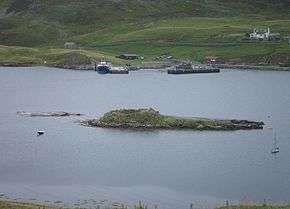Broch of West Burrafirth
Coordinates: 60°17′53″N 1°32′18″W / 60.298185°N 1.538235°W
 Remains of the broch on the little holm | |
 Shown within Shetland | |
| Location | Mainland, Shetland |
|---|---|
| Coordinates | 60°17′53″N 1°32′18″W / 60.298185°N 1.538235°W |
| Type | Broch |
| History | |
| Periods | Iron Age |
The Broch of West Burrafirth is an Iron Age broch located on the west side of Mainland, Shetland (grid reference HU25625720).
Location
The broch stands on a low rocky islet (the "Holm of Hebrista") in West Burra Firth.[1] The site is inaccessible without a boat except at very low tide.[1] There was once a causeway from the islet to the shore, which is no longer readily apparent.[1]
Description
The broch is in a ruined state with much fallen debris.[1] The entrance is blocked with stones but the lintel over the inner end is still apparent.[1] There appear to be two guard cells on either side of the entrance passage.[1] Internally four mural cells can be seen, two of which are dumb-bell shaped with short passages between the two halves.[1]
Later history
The Orkneyinga saga states of Magnus Erlendsson and Hákon Paulsson:
- "Magnus and Hákon ruled their lands and defended them for some time, the two agreeing very well... They also slew a famous man, named Þorbjörn in Borgarfjörð in Hjaltland."[2]
Borgarfjörð, the "fjord of the borg" was so named by the Norse on account of the broch.[2] It is probable that the reason of Þorbjörn's connection with Borgarfjörð/Burra Firth was its affording him, and his followers a shelter, and a defensive position in the borg, or broch.[2] The old name Borgarfjörð occurs in a document in the Norse language dated 1299.[2]
The broch was visited by George Low in the 18th century, when he noted a number of cells in the base of the wall, and he stated that a hollow, galleried wall began above these.[1]